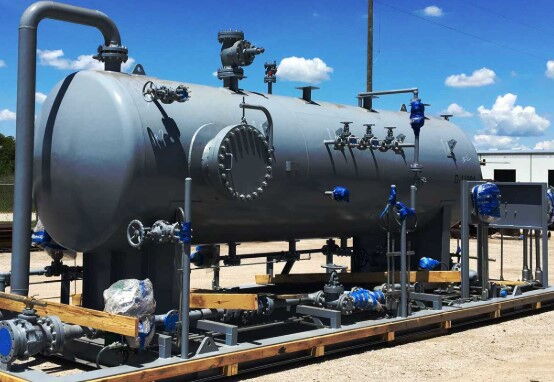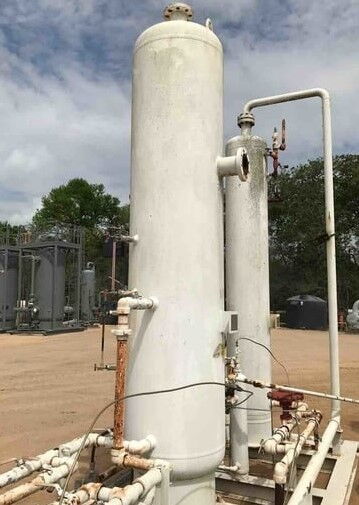In the oil industry, three-phase separators are key equipment for ensuring crude oil stability and dehydration efficiency. They can effectively separate the gas, oil, and water phases in crude oil, thereby ensuring crude oil quality and smooth downstream processing. Three-phase separators are mainly divided into horizontal and vertical types, each with its unique advantages and application scenarios. This article will focus on comparing horizontal and vertical three-phase separators, discussing in detail their characteristics, application scenarios, and selection points, to help readers better understand the differences and applicability of these two types of equipment.
Horizontal three-phase separators are currently the most widely used type on oil well platforms. Their design makes the gravity settling velocity perpendicular to the flow velocity. This unique structure makes horizontal separators more effective in separation using the gravity settling principle than vertical separators. Horizontal separators also have a larger interface area, which helps improve the phase equilibrium stabilization speed, especially when handling crude oil produced fluids containing bubbles or emulsions. Horizontal three-phase separators have strong liquid buffering capacity. Under the same static flow conditions, horizontal separators can better buffer liquids, providing more stable flow to downstream equipment. In addition, horizontal separators are easy to install, inspect, and maintain, and are convenient for skid-mounted fabrication. These features make horizontal three-phase separators highly economical and practical in actual applications.

Vertical three-phase separators are more effective when handling crude oil produced fluids with a low oil-gas ratio and solid particles. Therefore, vertical separators are mainly used on oilfield platforms with lower crude processing volumes and higher sand content. The greater height of vertical separators gives them an advantage in settling sand in oil and water and allows easy discharge of sediments from the bottom. However, the height also brings some issues. Without specially designed ladders and platforms, the internal control devices of the separator are difficult to operate. In addition, during transportation, if there are height restrictions, it may be necessary to remove containers from skid-mounted units. The cost of a vertical separator of the same volume is higher than that of a horizontal separator. The outer wall of a vertical separator is usually thicker than that of a horizontal separator, further increasing manufacturing costs.

Performance comparison is a key step in selecting suitable equipment, because different application scenarios have varying requirements for separation efficiency, buffering capacity, operational convenience, and cost. Only by clearly understanding the advantages and disadvantages of horizontal and vertical three-phase separators in these aspects can one make the most reasonable decision in actual applications.
Horizontal Three-Phase Separators: Horizontal separators occupy more space to complete the same separation task. However, their liquid buffering capacity is stronger. Under the same static flow conditions, horizontal separators can better buffer liquids, providing more stable flow to downstream equipment. This is particularly important for handling crude oil produced fluids with a high oil-gas ratio, as horizontal separators can effectively avoid interference with the oil-water interface caused by high inlet flow velocity.
Vertical Three-Phase Separators: Vertical separators occupy less space for the same separation task, which is an important advantage for space-limited oilfield platforms. However, their liquid buffering capacity is relatively weak. Under the same static flow conditions, vertical separators experience larger liquid level fluctuations and weaker buffering, which may adversely affect the stable operation of downstream equipment.
Horizontal Three-Phase Separators: The gravity settling velocity is perpendicular to flow velocity, making horizontal separators more effective than vertical ones in using gravity settling for separation. They also have a larger interface area, which helps improve phase equilibrium stabilization speed. Therefore, horizontal separators perform better when handling crude oil produced fluids containing bubbles or emulsions. Additionally, the large oil-water interface effectively prevents interference from high inlet flow velocity, making horizontal separators particularly suitable for handling high oil-gas ratio crude oil produced fluids.
Vertical Three-Phase Separators: Vertical separators are more effective when handling low oil-gas ratio and solid-containing crude oil produced fluids. Their greater height gives them an advantage in settling sand in oil and water and allows convenient bottom discharge of sediments. Therefore, vertical separators are mainly used on oilfield platforms with lower crude processing volumes and higher sand content.
Horizontal Three-Phase Separators: The lower height makes internal control devices easier to operate and maintain. Horizontal separators are also easy to install, inspect, maintain, and fabricate as skid-mounted units, giving them high economic and practical value in actual applications.
Vertical Three-Phase Separators: The greater height makes it difficult to operate internal control devices. Without specially designed ladders and platforms, operation and maintenance become very difficult. In addition, during transportation, if there are height limitations, containers on skid-mounted units may need to be removed, further increasing the complexity of transport and installation.
Horizontal Three-Phase Separators: For the same volume, horizontal separators cost less than vertical separators. Their outer walls are usually thinner, reducing manufacturing costs. Their economy and practicality make them the preferred choice for conventional oil-gas separation, especially for handling emulsions, foam, and high oil-gas ratio crude oil produced fluids.
Vertical Three-Phase Separators: For the same volume, vertical separators cost more than horizontal separators. Their outer walls are usually thicker, further increasing manufacturing costs. Additionally, if the vertical separator is exposed to strong wind, its lateral load must be considered, which further increases wall thickness and manufacturing costs.
Different oilfield conditions and crude oil characteristics determine which type of separator better meets production needs. Therefore, understanding the actual performance of horizontal and vertical separators is crucial for optimizing oilfield production processes and improving economic efficiency.
High oil-gas ratio crude oil produced fluids: Large oil-water interface prevents interference from high inlet flow velocity, ensuring separation stability.
Crude oil produced fluids containing bubbles or emulsions: The perpendicular gravity settling velocity and large interface area enhance separation, performing better than vertical separators.
Conventional oil-gas separation: Horizontal separators are effective for emulsions, foam, and high oil-gas ratio fluids, making them the preferred choice on most oilfield platforms.
Low oil-gas ratio crude oil produced fluids: Height aids sand settling and bottom discharge.
High-sand crude oil produced fluids: Height and structure facilitate sand settling and discharge, widely used on low-volume, high-sand platforms.
Space-limited oilfield platforms: Smaller footprint is an advantage in constrained spaces.
Selecting a suitable three-phase separator requires comprehensive consideration of factors including the characteristics of the fluid to be separated, oilfield production capacity, field production process, crude oil properties, and manufacturer capabilities. The main selection points include:
Viscosity, density, flow rate, and liquid content: Directly affect separator size and performance requirements. High viscosity and density may require larger separation area and longer residence time.
Oil-gas ratio and sand content: Critical for separator type selection. High oil-gas ratio favors horizontal separators, while low oil-gas ratio with high sand content favors vertical separators.
Production capacity: Determines separator handling capacity and size. High-production fields require larger separators.
Field production process: Complexity and special requirements may affect separator choice; some fields may require more efficient separation for complex crude oil produced fluids.
Cost: Horizontal separators of the same volume are usually less expensive. For limited budgets, horizontal separators may be more economical.
Operation and maintenance: Horizontal separators are easier to operate and maintain, particularly under space or transport constraints. Vertical separators, while advantageous in some areas, may have increased operational and maintenance complexity due to height and structure.
Horizontal and vertical three-phase separators each have advantages and disadvantages. Horizontal separators perform well for high oil-gas ratio, bubble-containing, or emulsified crude oil produced fluids, with strong liquid buffering and high economy. Vertical separators are more effective for low oil-gas ratio, high-sand fluids, and are advantageous on space-limited oilfield platforms. Users need to select the most suitable separator type based on fluid characteristics, oilfield production capacity, field processes, and economic factors to ensure efficient and stable oil and gas production.
Whether onshore or offshore, three-phase separators play an indispensable role. Proper selection and use of three-phase separators can effectively improve crude oil quality and downstream processing efficiency, providing strong support for sustainable development in the oil industry.

